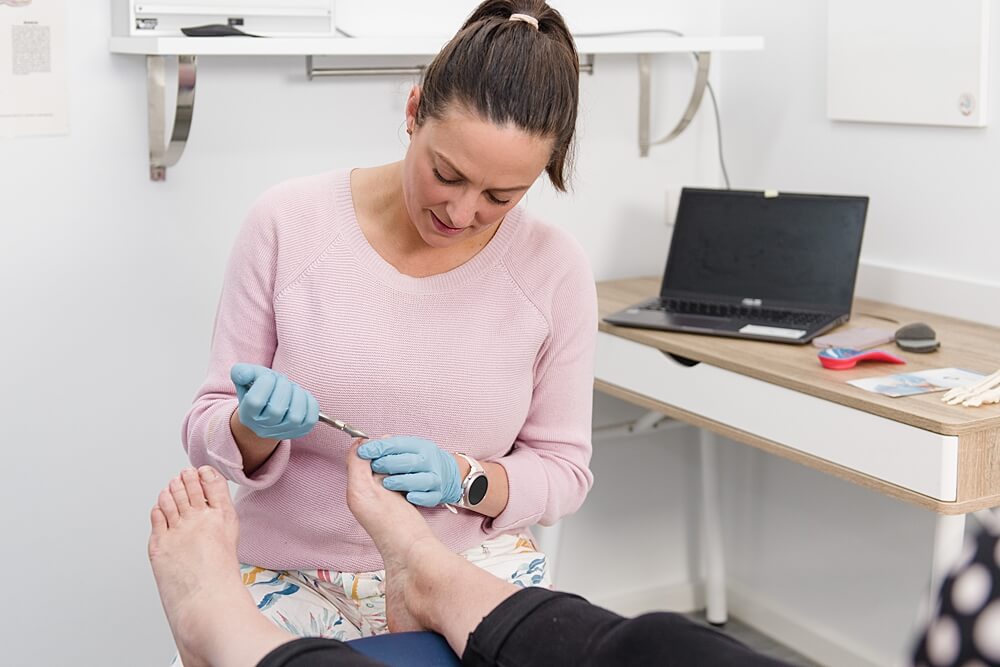Ingrown toenails can be more than just a nuisance; they can cause significant discomfort and even lead to infections if left untreated. Fortunately, podiatrists are well-equipped to handle this common issue with precision and expertise. In this article, we’ll delve into the various techniques podiatrists employ to effectively treat ingrown toenails and provide relief to their patients.
How do podiatrists assess the ingrown toenails?
Patient History
Podiatrists begin by gathering a comprehensive patient history, including any previous treatments for ingrown toenails, relevant medical conditions, and factors that may contribute to the condition’s onset or exacerbation. This helps in determining the most appropriate course of treatment.
Clinical Examination
A thorough clinical examination of the affected toe(s) is conducted to assess the severity of the ingrown toenail and any associated complications. Podiatrists inspect the nail, surrounding skin, and underlying structures for signs of inflammation, infection, or other abnormalities. They may also evaluate the patient’s gait and footwear to identify potential contributing factors.
Diagnostic Imaging
In some rare cases, diagnostic imaging such as X-rays may be ordered to assess the extent of the ingrown toenail and identify any underlying bone abnormalities or infections. X-rays can provide valuable insights into the condition’s severity and guide treatment planning.
Pain Assessment
Podiatrists assess the patient’s level of pain and discomfort associated with the ingrown toenail. This helps in determining the urgency of treatment and selecting appropriate pain management strategies.
What are the podiatrist treatments for ingrown toenails?
Podiatrists regularly treat ingrown toenails, a common foot problem, with various approaches depending on the severity of the condition. Here are the most common methods used by podiatrists to treat an ingrown toenail:
Conservative Management:
- Soaking: Mild cases of ingrown toenails may be treated with warm water soaks, usually mixed with Epsom salts, to reduce inflammation and infection risk.
- Proper Trimming: Podiatrists can demonstrate the correct way to trim toenails, emphasising straight across rather than rounded edges to prevent ingrowth.
Oral Antibiotics:
If the ingrown toenail is infected, your endorsed podiatrist may prescribe oral antibiotics to clear the infection. Antibiotics may be used in conjunction with other treatments.
Nail bracing
For ingrown toenails that are not suitable for surgical intervention, podiatrists often perform a nail bracing procedure that works on flattening the nail plate.
Nail Removal:
In some severe or recurrent cases, podiatrists may recommend ingrown toenail surgery. This procedure is typically reserved for worser cases or when other treatments have been unsuccessful.
After the part of the nail is removed, the nail matrix may also be treated to prevent future nail regrowth.
Chemical or Phenolisation Procedure:
Following a partial nail removal, podiatrists may use a chemical (typically phenol) to destroy the nail matrix tissue. This is done to ensure that the ingrown portion of the nail does not regrow.
The chemical is applied directly to the nail matrix, effectively stopping regrowth in that area. It may also help prevent ingrown nails from returning.
Post-Procedure Care
After any nail procedure, podiatrists will provide instructions for proper wound care and may prescribe antibiotics or pain medication if needed. They will also advise on ways to prevent ingrown toenails in the future, such as proper nail trimming techniques and wearing properly fitting shoes
It’s important to note that the specific treatment plan will depend on the individual case and the podiatrist’s assessment.
When should I see a podiatrist for ingrown toenail treatment?
It’s advisable to see a podiatrist for ingrown toenail treatment if you experience persistent pain, swelling, redness, or signs of infection around the toenail. Early intervention can prevent complications and promote faster healing.
If you suspect you have an ingrown toenail or are experiencing pain, contact Highett Podiatry to prevent complications and obtain effective treatment.
How can I prevent ingrown toenails?
Preventive measures include proper nail trimming techniques, wearing well-fitting shoes, maintaining good foot hygiene, and seeking prompt treatment for any signs of nail abnormalities.
How long does it take to recover from ingrown toenail treatment?
Recovery time depends on the type of treatment performed and individual healing factors. Most people can resume normal activities within a few days to a week after treatment.
Is ingrown toenail removal painful?
The procedure for ingrown toenail removal typically involves the use of local anesthesia to numb the toe, ensuring that the process is generally pain-free. While you may feel a brief sting or discomfort from the anesthesia injection, the toe should be numb during the actual removal process. Any pressure or mild discomfort experienced during the procedure is usually well-tolerated by most individuals.
Can ingrown toenails recur after treatment?
There is a possibility of ingrown toenails recurring, especially if predisposing factors such as improper nail trimming or tight footwear are not addressed. However, proper preventive
Are there any complications associated with ingrown toenails?
Yes, if left untreated, ingrown toenails can lead to infections, abscesses, or even more severe complications such as cellulitis or osteomyelitis. Seeking prompt treatment from a podiatrist can help prevent such complications.
Can ingrown toenails affect other parts of the foot or body?
While ingrown toenails primarily affect the toes, severe cases or complications like infections can potentially spread to other parts of the foot or even the rest of the body if left untreated. It’s essential to address ingrown toenails promptly to prevent such complications.

